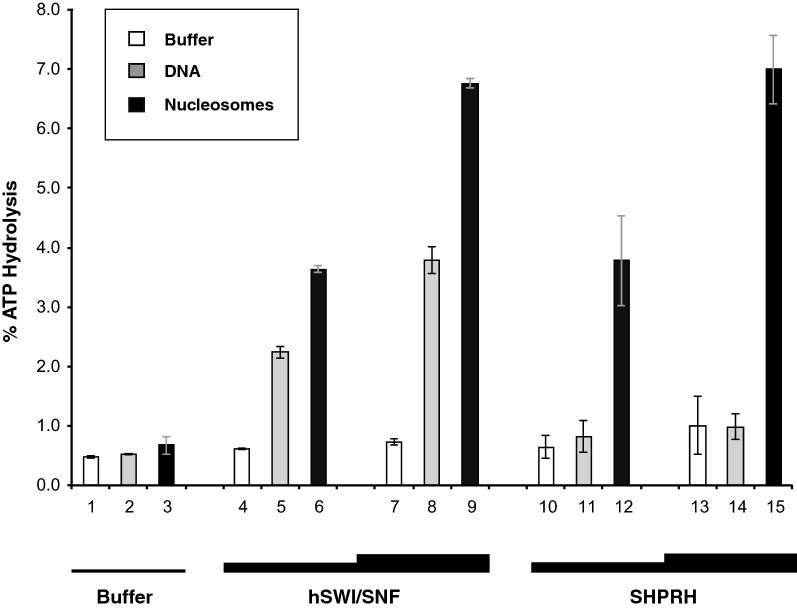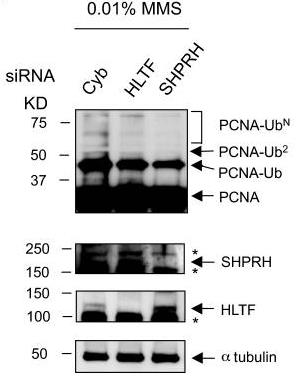SHPRH
-
Official Full Name
SNF2 histone linker PHD RING helicase, E3 ubiquitin protein ligase -
Overview
SHPRH is a ubiquitously expressed protein that contains motifs characteristics of several DNA repair proteins, transcription factors, and helicases. SHPRH is a functional homolog of S. cerevisiae RAD5 (Unk et al., 2006 [PubMed 17108083]).[supplied by OMIM, Mar 2008] -
Synonyms
SHPRH;SNF2 histone linker PHD RING helicase, E3 ubiquitin protein ligase;bA545I5.2;E3 ubiquitin-protein ligase SHPRH;2610103K11Rik;SNF2, histone-linker, PHD and RING finger domain-containing helicase
Recombinant Proteins
- Human
- Mouse
- Rhesus macaque
- E.coli
- Mammalian Cell
- HEK293
- His
- His&Fc&Avi
| Cat.# | Product name | Source (Host) | Species | Tag | Protein Length | Price |
|---|---|---|---|---|---|---|
| SHPRH-2666H | Recombinant Human SHPRH, His-tagged | E.coli | Human | His | C-350aa | |
| SHPRH-15113M | Recombinant Mouse SHPRH Protein | Mammalian Cell | Mouse | His |
|
|
| SHPRH-4198R | Recombinant Rhesus monkey SHPRH Protein, His-tagged | Mammalian Cell | Rhesus macaque | His |
|
|
| SHPRH-4014R | Recombinant Rhesus Macaque SHPRH Protein, His (Fc)-Avi-tagged | HEK293 | Rhesus macaque | His&Fc&Avi |
|
|
| SHPRH-4014R-B | Recombinant Rhesus Macaque SHPRH Protein Pre-coupled Magnetic Beads | HEK293 | Rhesus macaque |
|
||
| SHPRH-8161M | Recombinant Mouse SHPRH Protein, His (Fc)-Avi-tagged | HEK293 | Mouse | His&Fc&Avi |
|
|
| SHPRH-8161M-B | Recombinant Mouse SHPRH Protein Pre-coupled Magnetic Beads | HEK293 | Mouse |
|
Background
What is SHPRH Protein?
SHPRH, or SNF2 histone-linker PHD RING helicase, is a widely expressed protein crucial for keeping our genome stable, especially during DNA replication. It shares functions with yeast RAD5, playing a part in DNA repair and transcription regulation. SHPRH has domains like SNF2_N, H1/H5-like fold, PHD zinc finger, RING finger, and helicase_C. It helps bypass DNA damage by activating pathways like template switching (TS) and promotes DNA repair. Additionally, it aids in rRNA transcription by recognizing acetylation at histone H3K56. SHPRH also acts as an E3 ubiquitin ligase, specifically targeting PCNA for degradation. Overall, SHPRH is vital for DNA repair, transcription regulation, and genomic stability.What is the Function of SHPRH Protein?
SHPRH protein is like a multi-tool for DNA repair, featuring various domains, including SNF2_N, H1/H5-like, PHD zinc finger, RING, and helicase_C. It helps fix DNA damage by activating a bypass route and is involved in PCNA’s multi-ubiquitination—key for keeping the genome stable. Besides, SHPRH boosts rRNA transcription by spotting acetylation at histone H3K56. Acting as an E3 ubiquitin ligase, it helps build ubiquitin chains, possibly recruiting repair factors or aiding in protein degradation. It’s also a tumor suppressor gene, and its malfunction might spark or worsen cancers. Thus, SHPRH plays a vital part in genome stability, transcription regulation, and cancer prevention.SHPRH Related Signaling Pathway
SHPRH protein plays a crucial role in DNA repair and cancer suppression. As an E3 ubiquitin ligase, it helps regulate TLS by facilitating PCNA polyubiquitination during DNA replication. SHPRH is also involved in rRNA transcription and is linked to the Wnt signaling pathway. Inactivation of SHPRH is associated with several cancers, such as colorectal and lung adenocarcinomas. Additionally, it affects tumor progression through miRNA interactions; for example, circ-SHPRH acts as a miRNA sponge influencing gene expression and inhibiting cancer cell growth in cancers like liver and stomach. This highlights SHPRH’s vital function in DNA damage response, transcription regulation, and tumor pathways.SHPRH Related Diseases
SHPRH protein is linked to various diseases, including skin disorders, cancer, and autoimmune diseases. It’s associated with genetic conditions like Xeroderma Pigmentosum and Fanconi Anemia. In cancer, SHPRH acts as a tumor suppressor in lung adenocarcinoma, correlating with better outcomes and may predict DNA damage responses. Its circular peptide form can inhibit tumor traits in neuroblastoma. In colorectal cancer, SHPRH suppresses the Wnt signaling pathway, suggesting its inactivation could spur tumor growth. It’s also involved in autoimmune diseases, where Wnt pathway disruptions are connected to conditions like lupus and rheumatoid arthritis. Thus, SHPRH is vital for studying and treating these diverse health issues.
Fig1. Schematic illustration showing the molecular mechanisms of circ-SHPRH in multiple cancers. (Hong Xiong, 2023)
Bioapplications of SHPRH
Recombinant SHPRH protein is crucial in research, industry, and medical studies. It’s widely used to explore its roles in DNA repair and transcription regulation, involving mechanisms like DNA damage tolerance and synthesis. With E3 ubiquitin ligase activity, SHPRH works with multiple E2 enzymes, impacting repair and transcription. In industry, it’s used to develop antibodies reactive in experiments like Western Blot and ELISA. Medically, SHPRH’s role in tumor progression, particularly as a DNA damage response regulator in lung adenocarcinoma, makes it a key focus. Overall, recombinant SHPRH is essential in advancing DNA repair and cancer research.Case Study
Case Study 1: Brühl J. et al. Epigenetics Chromatin. 2019
DNA integrity during replication is key to organism survival. In eukaryotes, when replication machinery encounters DNA damage, it can lead to serious issues if not addressed, such as chromosome rearrangements. SHPRH, akin to yeast’s RAD5, plays a role in bypassing DNA damage by catalyzing PCNA polyubiquitination. Though primarily studied for this function, SHPRH’s broader role in DNA repair and gene transcription is unclear. Our investigation shows that SHPRH binds well to both dsDNA and nucleosomes, with a preference for nucleosomes with extranucleosomal DNA, and its activity is stimulated by nucleosomes. Surprisingly, while it acts as an E3 ligase with at least 7 E2 enzymes, its ATPase activity doesn’t result in typical nucleosome remodeling. Mass spectrometry indicates SHPRH can form polyubiquitin linkages aiding DNA repair or degradation processes.-
 Fig1. SHPRH is a nucleosome-stimulated but not a dsDNA-stimulated ATPase.
Fig1. SHPRH is a nucleosome-stimulated but not a dsDNA-stimulated ATPase. -
 Fig2. Nucleosome mobilization assay.
Fig2. Nucleosome mobilization assay.
Case Study 2: Motegi A. et al. Proc Natl Acad Sci U S A. 2008
Prolonged stalling of DNA replication due to damage can destabilize the genome. To handle this, cells use lesion-bypass systems like postreplication repair (PRR). In yeast, one PRR branch involves PCNA polyubiquitination via the Rad5-Ubc13-Mms2 complex for lesion bypass through template switching. We’ve identified human SHPRH as a yeast Rad5 homologue, confirming a similar pathway in human cells. Now, HLTF emerges as another Rad5-like player, sharing domain structures with Rad5 and enabling lysine 63-linked PCNA polyubiquitination. Both HLTF and SHPRH interact with UBC13 and PCNA and reducing their levels increases mutation rates. Also, HLTF-deficient mouse cells show more chromosome issues after methyl methanesulfonate exposure. These findings suggest that HLTF and SHPRH together help maintain genome stability by acting similarly to yeast Rad5.-
 Fig3. HLTF and SHPRH cooperatively promote PCNA polyubiquitination.
Fig3. HLTF and SHPRH cooperatively promote PCNA polyubiquitination. -
 Fig4. The reduction of HLTF or SHPRH expression by siRNA reduced PCNA polyubiquitination.
Fig4. The reduction of HLTF or SHPRH expression by siRNA reduced PCNA polyubiquitination.
Involved Pathway
SHPRH involved in several pathways and played different roles in them. We selected most pathways SHPRH participated on our site, such as , which may be useful for your reference. Also, other proteins which involved in the same pathway with SHPRH were listed below. Creative BioMart supplied nearly all the proteins listed, you can search them on our site.
| Pathway Name | Pathway Related Protein |
|---|
-
 Fig1. Rad5 and human homologs interact with the MMR pathway. (Anna K Miller, 2022)
Fig1. Rad5 and human homologs interact with the MMR pathway. (Anna K Miller, 2022) -
 Fig2. MicroRNAs that can be sponged by circ-SHPRH or genes and proteins associated with circ-SHPRH, according to published reports on human cancer. (Xinyue Ju, 2021)
Fig2. MicroRNAs that can be sponged by circ-SHPRH or genes and proteins associated with circ-SHPRH, according to published reports on human cancer. (Xinyue Ju, 2021)
Protein Function
SHPRH has several biochemical functions, for example, ATP binding,DNA binding,helicase activity. Some of the functions are cooperated with other proteins, some of the functions could acted by SHPRH itself. We selected most functions SHPRH had, and list some proteins which have the same functions with SHPRH. You can find most of the proteins on our site.
| Function | Related Protein |
|---|---|
| helicase activity | HELZ2,PEO1,FANCM,DDX39,RTEL1,CHD9,HLTF,MCM3L,YTHDC2,HELZ |
| protein binding | KDM4A,CHDH,BORA,ZNF350,USP20,EYA1,CC10,HILPDA,CD63,NGLY1 |
| ligase activity | TRIP12,TRIML2,RNF43,NAPRT1,CTPS1A,MKRN3,TTLL5,UBE2NB,RNF139,MYLIPA |
| DNA binding | RNF141,HOXB8B,ARHGEF38,GTF2F1,EP400,TBX1,PAX1A,MESP1,MXTX1,EF1 |
| ATP binding | ATAD5B,DDX3Y,LIMK1,ABCG2,TTLL6,CAMK1DB,TSSK5,ABCG4B,PLK2,NME2 |
| ubiquitin-protein transferase activity | BIRC5B,MARCH1,WWP2,FBXL14,ZNRF3,RNF115,PDZRN3,RNF31,UBE3C,MUL1 |
| zinc ion binding | MAP3K1,RNF113B,G2E3,RNF144A,KDM7AB,FBXO30B,FHL2A,TAF3,CSRP1A,ZDHHC9 |
Interacting Protein
SHPRH has direct interactions with proteins and molecules. Those interactions were detected by several methods such as yeast two hybrid, co-IP, pull-down and so on. We selected proteins and molecules interacted with SHPRH here. Most of them are supplied by our site. Hope this information will be useful for your research of SHPRH.
EDARADD;C17orf59;USP49;USP36;FDFT1;LPP;FBXW7
Resources
Related Services
Related Products
References


